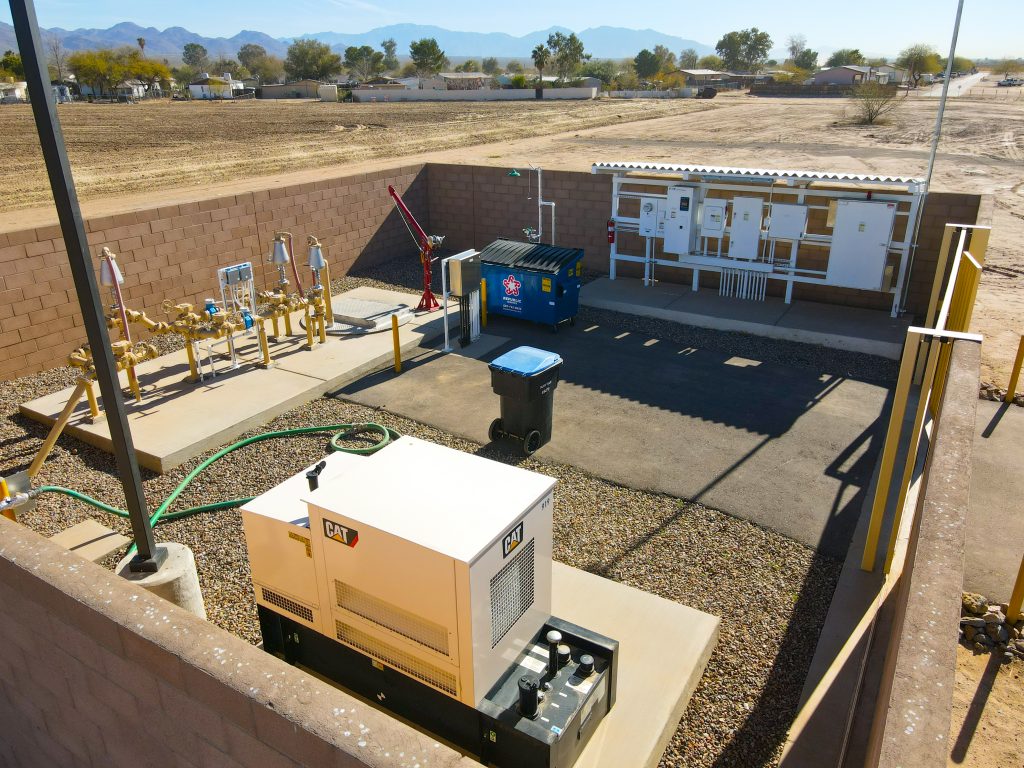
It’s time to vote in the #ELGLKnope Round of 32! Read about this matchup, and then submit your vote! One vote per email address, please. We’ll tally the votes and will post the next round of matchups on Tuesday!
Vote! Vote! Vote!

Adonis Lift Station
11555 W Civic Center Dr, Arizona 85653
- Three words to describe Adonis Lift Station: Upgrade, Community, Investment
- Why are you nominating Adonis Lift Station: We took over the small sewer system in August 2017 and began a investigation on the condition of the system. During the investigation we located several manholes that were below grade, adjusted them back to existing grade, and found two sections of main in need of immediate repair. We made those repairs using cured in place patches with little to no interruption in service. After the imminent concerns were addressed, we began design to upgrade the out of code lift station, and a force main to allow flow from the neighborhood to be treated at the Marana Water Reclamation Facility instead of the open-air existing evaporation lagoons. In October 2020, construction was completed of the lift station and force main and the lagoons began the drying out process. Once the lagoons are dry, the clean/close process can begin. This process will include the removal of dried solids and soil sample collection. If contaminated soil is found under the lagoons, that material will be removed and disposed of. Once all contaminates are removed from the site, the lagoons will officially be closed.
- Anything else to share?

Sierra Vista Environmental Operations Park
Sierra Vista, Arizona 85635
- Three words to describe Sierra Vista Environmental Operations Park: Recharge
Multifaceted
Model - Why are you nominating Sierra Vista Environmental Operations Park: There are wastewater treatment facilities, and then there’s the Sierra Vista Environmental Operations Park (EOP). The EOP has been recharging water into the aquifer below Sierra Vista since 2002. To date, more than 11 billion gallons of clean water have made it into the aquifer, which has helped support the San Pedro River, part of the San Pedro Riparian National Conservation Area. The impact of the EOP in supporting the base flows of the San Pedro River is well documented, and due to its success, the EOP has become a “proof of concept” model for other recharge facilities both locally and throughout the desert southwest. By simultaneously replenishing groundwater supplies and buffering the San Pedro River from groundwater withdrawals, the EOP is helping to create a sustainable future for the area, including the U.S. Army installation Fort Huachuca.
- Anything else to share? Here in the desert Southwest, water is life, money, and often the source of a lot of litigation. At over 4,700 feet above sea level in the southeast corner of Arizona, the City of Sierra Vista enjoys lower temperatures and more precipitation than lower-lying areas of Arizona, but water conservation is still a top priority. Add in the San Pedro River, which is the last free-flowing river in the Southwest, and the U.S. Army installation Fort Huachuca with its own environmental challenges, and water conservation then becomes necessary for our community’s survival and future growth potential.
But the EOP doesn’t just treat wastewater and recharge billions of gallons into an aquifer, it also creates wetlands for many species, and even creates compost for fertilizer.
After preliminary treatment, wastewater flows by gravity to anoxic and aeration basins. In the aeration basin, the water is mixed with air to provide the bacteria in the treatment process with oxygen. Ammonia nitrogen is converted to nitrate nitrogen and then converted to nitrogen gas in the anoxic basin. The denitrified water then flows to the clarifiers, which act as a settling tank. Here, solids settle to the bottom and the clear effluent flows to the wetlands.
The wetlands remove any remaining nitrogen, and serve as a habitat for many species of birds, mammals, and amphibious creatures. Many birdwatchers travel from all over the country to visit the 1,800 sq ft viewing platform, and guided bird walks are offered periodically throughout most of the year.
Biosolids removed from the treatment process are dewatered and delivered to the City’s composting facility next door to the EOP where it is mixed with green material. After treatment, the finished compost meets the U.S. EPA Class A Exceptional Quality standard under 40 CFR Part 503. This level of treatment imposes the strictest requirements for pathogen reduction and vector attraction reduction. By meeting this standard, the City of Sierra Vista is able to sell the Class A composted biosolids to farmers, park agencies, and the general public to use as fertilizer or as a soil amendment.
